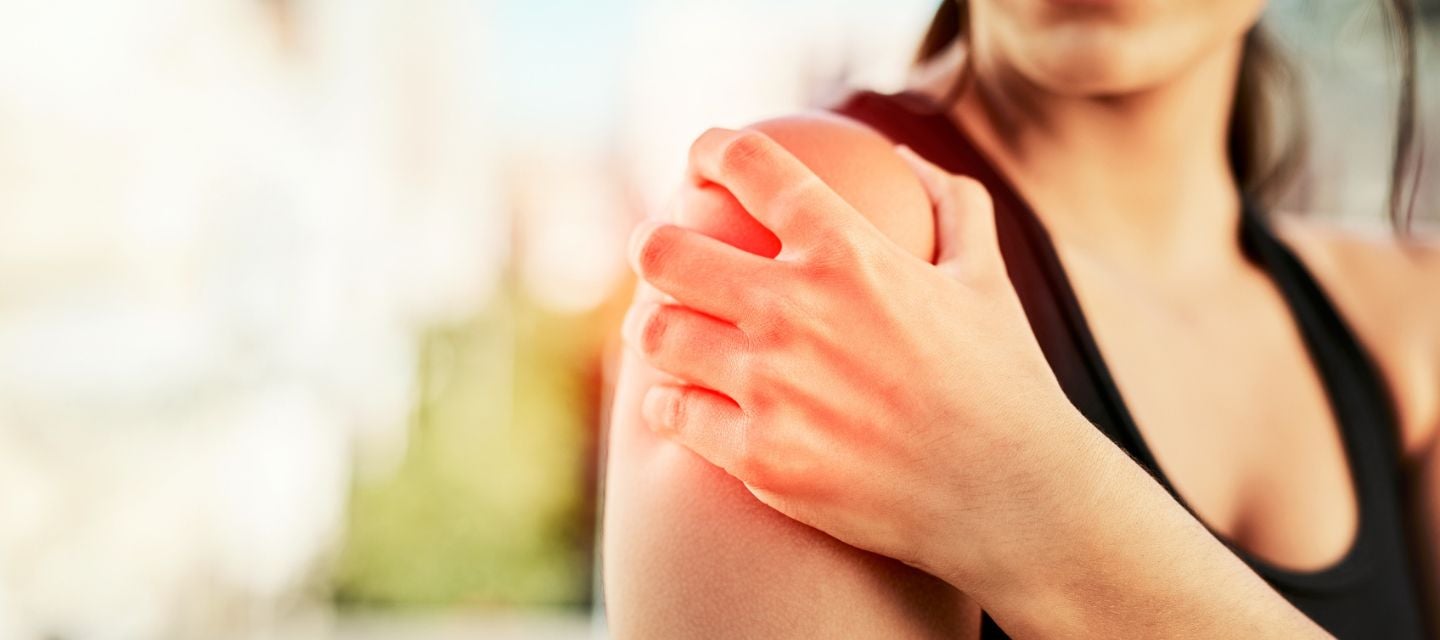
27 June 2022
The three most common shoulder injuries
27 June 2022
The three most common shoulder injuries

About the shoulder joint
The shoulder joint is unique in the human body. Its ball and socket structure provides an excellent range of motion; however, this freedom comes at the expense of rigidity and stability.
The shoulder joint is formed where the humerus, scapula and clavicular bones meet. Additionally, there is significant gliding motion present in the “joint” between the scapula and the rib cage. The humerus fits into a rounded socket in the scapula like a “golf Ball” on a “tee”. The joint is stabilised by a group of muscles and tendons, known as a rotator cuff.
As the body’s most mobile joint, the shoulder is at the greatest risk of injury, particularly amongst athletes and those performing repetitive activities at work. Injuries to the shoulder tend to occur either acutely from a single impact such as a heavy fall, or over time due to repeated overhead movements.
This article highlights the risk factors, prevention, and treatment options for the three most common injuries that affect the shoulder.
1. Shoulder dislocation/instability
Shoulder instability occurs when the muscles and ligaments holding the joint in place are stretched or torn. In younger patients, these injuries occur most often in athletes. In older adults this is most commonly associated with degeneration of the rotator cuff.
Certain athletic movements such as bowling a cricket ball, pitching sports like baseball or tackling another player in a football match put excessive force on the shoulder and can stretch the ligaments and joint capsule, causing instability to occur over time. Acute dislocation can occur if the force is large enough, like in a tackle.
Acromioclavicular joint separation
Separation (also known as a sprain), occurs when the ligaments attached to the clavicle are torn. These injuries tend to occur due to a single heavy impact such as falling and landing on an outstretched hand or arm.
Sprains/ separations are usually painful. Movement of the shoulder becomes severely limited and the area around the joint can appear misshapen.
Ice should be applied immediately to reduce swelling. Treatment can include keeping the arm in a sling, physical therapy, and surgery in some cases.
Shoulder Dislocation
This occurs when the humerus pops out of the shoulder socket, when the shoulder is pulled on too hard or rotated too far. The ligaments attached to the shoulder bones are torn and can’t hold the joint together.
These injuries can be caused by falling onto an outstretched hand, impacting the shoulder joint itself or if the joint is twisted violently.
Dislocations should be iced immediately and require urgent care. The primary symptom is pain radiating from the joint that increases with movement. Treatment involves relocating the joint and can include immobilising the arm in a sling, physical therapy as well as surgery in recurring cases.
2. Rotator cuff tear
The rotator cuff is a group of small muscles and tendons that allow shoulder stabilisation and rotation and lifting movements. It keeps the ball (head) of your humerus (upper arm) in the shoulder socket.
If the tendons of the rotator cuff are torn, the humerus can’t move in its socket properly. This results in difficulty raising the arm or moving it away from the body.
Rotator cuff injuries occur most often in older adults. Performing repetitive movements with the arms, particularly overhead, is a primary risk factor. Rotator cuff tendons can be injured or torn when trying to lift something heavy or catch a heavy object with the arms outstretched.
Treatment for rotator cuff tears generally involves rest and icing the area. Non-steroidal anti-inflammatory (NSAID) drugs can help ease pain and inflammation. Treatment should be sought for suspected rotator cuff injuries and can include physical therapy.
3. SLAP tear
A SLAP tear refers to a tear in the labral cartilage which is attached around the periphery of the scapular “socket”. The acronym stands for Superior Labral tear from Anterior to Posterior.
SLAP tears can be difficult to diagnose, as symptoms overlap with those of other shoulder injuries. Tears tend to develop over time due to performing repetitive overhead movements.
Symptoms include pain, a feeling of reduced power in the shoulder, and instability of the joint. Range of motion tends to decrease, often accompanied by a dull, achy pain that can be felt deep within the shoulder but can be difficult to pinpoint.
Diagnosing shoulder injuries with MRI
MRI of the shoulder provides highly detailed images of the structures within the joint from any angle. It’s a non-invasive test and provides clinicians with a clear view to diagnose tears to the rotator cuff, biceps tendon or labrum.
The procedure is particularly useful for diagnosis of sports and work-related injuries caused by repetitive strain.
Patients suffering a decreased range of motion of the shoulder joint that’s not improving over time, or unexplained shoulder pain that’s not responding to treatment, should talk to their health care providers about using MRI to aid diagnosis.
More information
A shoulder MRI can help your doctor to characterise and diagnose a variety of medical conditions, including the causation of shoulder pain, sports related injuries, bone fractures not visible on other imaging tests, tumours of the bone and adjacent soft tissues and occasionally when there is persistent pain after surgery. Find out more here.
Remember to always discuss your medical condition with a doctor first, so they can assess your injury, and then recommend the best course of action or treatment.
Why you can trust I-MED Radiology
Our team of content writers create website materials that adhere to the principals set out in content guidelines, to ensure accuracy and fairness for our patients. Dr. Ronald Shnier, our Chief Medical Officer, personally oversees the fact-checking process, drawing from his extensive 30-year experience and specialised training in radiology.
